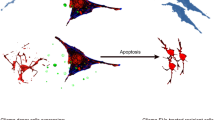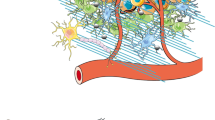Abstract
Extracellular vesicles (EVs) have been implicated in tumorigenesis. Biomolecules which can block EV binding and uptake into recipient cells may be of therapeutic value as well as enhance understanding of EV biology. Here, we show that heparin interacts with uptake of tumor-derived as well as non-tumor-derived EVs into recipient cells. Incubation of glioma cell-derived EVs with heparin resulted in micron-sized structures observed by transmission electron microscopy, with EVs clearly visible within these structures. Inclusion of heparin greatly diminished transfer of labeled EVs from donor to recipient tumor cells. We also show a direct interaction between heparin and EVs using confocal microscopy. We found that the block in EV uptake was at the level of cell binding and not internalization. Finally, incubation of glioma-derived EVs containing EGFRvIII mRNA with heparin reduced transfer of this message to recipient cells. The effect of heparin on EVs uptake may provide a unique tool to study EV function. It may also foster research of heparin or its derivatives as a therapeutic for disease in which EVs play a role.



Similar content being viewed by others
Abbreviations
- DIC:
-
Differential interference contrast
- DMEM:
-
Dulbecco’s modified eagle’s medium
- EV:
-
Extracellular vesicle
- EGFR:
-
Epidermal growth factor receptor
- FBS:
-
Fetal bovine serum
- FITC:
-
Fluorescein isothiocyanate
- GAG:
-
Glycosaminoglycan
- GBM:
-
Glioblastoma
- hEGF:
-
Human epidermal growth factor
- HSPG:
-
Heparan sulfate proteoglycans
- HUVECs:
-
Human umbilical vein endothelial cells
- RT:
-
Room temperature
- TEM:
-
Transmission electron microscopy
References
Dolecek TA, Propp JM, Stroup NE, Kruchko C. 2012. CBTRUS statistical report: primary brain and central nervous system tumors diagnosed in the United States in 2005–2009. Neuro-Oncol, 14 (suppl 5): v1–v49
Al-Nedawi K, Meehan B, Rak J (2009) Microvesicles: messengers and mediators of tumor progression. Cell Cycle 8(13):2014–2018
Théry C, Zitvogel L, Amigorena S (2002) Exosomes: composition, biogenesis and function. Nat Rev Immunol 2(8):569–579
Chaput N, Taieb J, Andre F, Zitvogel L (2005) The potential of exosomes in immunotherapy. Expert Opin Biol Ther 5:737–747
Wieckowski E, Whiteside TL (2006) Human tumor-derived vs dendritic cell-derived exosomes have distinct biologic roles and molecular profiles. Immunol Res 36(1–3):247–254
Clayton A, Mitchell JP, Court J, Mason MD, Tabi Z (2007) Human tumor-derived exosomes selectively impair lymphocyte responses to interleukin-2. Cancer Res 67(15):7458–7466
Balaj L, Lessard R, Dai L, Cho Y-J, Pomeroy SL, Breakefield XO (2011) Tumour microvesicles contain retrotransposon elements and amplified oncogene sequences. Nat Commun 2:180
Maguire CA, Balaj L, Sivaraman S, Crommentuijn M, Ericsson M, Mincheva-Nilsson L et al (2012) Microvesicle-associated AAV vector as a novel gene delivery system. Mol Ther 20:960–971
Maguire CA, Meijer DH, LeRoy SG, Tierney LA, Broekman ML, Costa FF et al (2008) Preventing growth of brain tumors by creating a zone of resistance. Mol Ther 16(10):1695–1702
Skog J, Würdinger T, van Rijn S, Meijer D, Gainche L, Curry WTJ et al (2008) Glioblastoma microvesicles transport RNA and protein that promote tumor growth and provide diagnostic biomarkers. Nat Cell Biol 10:1470–1476
Pegtel DM, Cosmopoulos K, Thorley-Lawson DA, van Eijndhoven MA, Hopmans ES, Lindenberg JL, de Gruijl TD, Würdinger T, Middeldorp JM (2010) Functional delivery of viral miRNAs via exosomes. PNAS 107(14):6328–6333
Sustar V, Jansa R, Frank M, Hagerstrand H, Krzan M, Iglic A, Kralj-Iglic V (2009) Suppression of membrane microvesiculation–a possible anticoagulant and anti-tumor progression effect of heparin. Blood Cells Mol Dis 42(3):223–227
Nagai A, Sato T, Akimoto N, Ito A, Sumida M (2005) Isolation and identification of histone H3 protein enriched in microvesicles secreted from cultured sebocytes. Endocrinology 146:2593–2601
Baietti MF, Zhang Z, Mortier E, Melchior A, Degeest G, Geeraerts A et al (2012) Syndecan-syntenin-ALIX regulates the biogenesis of exosomes. Nat Cell Biol 14:677–685
Smorenburg SM, Hettiarachchi RJ, Vink R, Büller HR (1999) The effects of unfractionated heparin on survival in patients with malignancy-a systematic review. Thromb Haemost 82:1600–1604
Van Noorden CJ, van Sluis GL, Spek CA (2010) Experimental and clinical effects of anticoagulants on cancer progression. Thromb Res 125(Suppl 2):S77–S79
Lebeau B, Chastang C, Brechot JM, Capron F, Dautzenberg B, Delaisements C et al (1994) Subcutaneous heparin treatment increases survival in small cell lung cancer. “Petites Cellules” Group. Cancer 74:38–45
Nitti D, Wils J, Sahmoud T, Curran D, Couvreur ML, Lise M et al (1997) Final results of a phase III clinical trial on adjuvant intraportal infusion with heparin and 5-fluorouracil (5-FU) in resectable colon cancer (EORTC GITCCG 1983-1987). European Organization for Research and Treatment of Cancer. Gastrointestinal Tract Cancer Cooperative Group. Eur J Cancer 33:1209–1215
Ornstein DL, Zacharski LR (1999) The use of heparin for treating human malignancies. Haemostasis S1:48–60
Gerotziafas GT, Papageorgiou C, Hatmi M, Samama MM, Elalamy I (2008) Clinical studies with anticoagulants to improve survival in cancer patients. Pathophysiol Haemost Thromb 36:204–211
Zacharski LR, Ornstein DL (1998) Heparin and cancer. Thromb Haemost 80:10–23
Engelberg H (1999) Actions of heparin that may affect the malignant process. Cancer 85:257–272
Hejna M, Raderer M, Zielinski CC (1999) Inhibition of metastases by anticoagulants. J Natl Cancer Inst 91:22–36
Hettiarachchi RJ, Smorenburg SM, Ginsberg J, Levine M, Prins MH, Büller HR (1999) Do heparins do more than just treat thrombosis? The influence of heparins on cancer spread. Thromb Haemost 82:947–952
Borsig L, Wong R, Feramisco J, Nadeau DR, Varki NM, Varki A (2001) Heparin and cancer revisited: mechanistic connections involving platelets, P-selectin, carcinoma mucins, and tumor metastasis. Proc Natl Acad Sci USA 98:3352–3357
Niers TM, Klerk CP, DiNisio M, Van Noorden CJ, Büller HR, Reitsma PH et al (2007) Mechanisms of heparin induced anti-cancer activity in experimental cancer models. Crit Rev Oncol Hematol 61:195–207
Nader HB, Chavante SF, dos-Santos EA, Oliveira TW, de-Paiva JF, Jerônimo SM et al (1999) Heparan sulfates and heparins: similar compounds performing the same functions in vertebrates and invertebrates? Braz J Med Biol Res 32:529–538
Ginsberg JS (1996) Management of venous thromboembolism. N Engl J Med 335:1816–1828
Acknowledgments
This work was supported by NIH/NINDS 1 R21 NS081374-01 (C.A.M.) NIH/NCI grants CA069246 (X.O.B), CA141226 (X.O.B.); CA156009 (X.O.B.) CA141150 (X.O.B.), an American Brain Tumor Association Fellowship (C.A.M.), and a 2010 AMC Scholarship, University of Amsterdam (N.A.A.). We gratefully acknowledge the Neuroscience Center PCR Core facility, which is funded by PHS grant P30NS045776. We acknowledge the MGH Neuroscience Center Microscopy and Image Analysis Core, which is funded by NIH grant P30NS045776. We thank the van Leeuwenhoek Center for Advanced Microscopy (LCAM) at the Academic Medical Center (University of Amsterdam, the Netherlands) for performing the transmission electron microscopy sample processing and imaging. We thank Lori LoGuidice and Ard Jonker (University of Amsterdam) for technical help. C.A.M. has a financial interest in Exosome Diagnostics, Inc. C.A.M.’s interests were reviewed and are managed by the Massachusetts General Hospital and Partners HealthCare in accordance with their conflict of interest policies. J.S. is an inventor on the exosome/EVs technology used in this study which has been licensed to Exosome Diagnostics, Inc. He holds equity in, and is now an employee of that company. X.O.B. is on the Scientific Advisory Board of Exosome Diagnostics, Inc.
Author information
Authors and Affiliations
Corresponding author
Electronic supplementary material
Below is the link to the electronic supplementary material.
Rights and permissions
About this article
Cite this article
Atai, N.A., Balaj, L., van Veen, H. et al. Heparin blocks transfer of extracellular vesicles between donor and recipient cells. J Neurooncol 115, 343–351 (2013). https://doi.org/10.1007/s11060-013-1235-y
Received:
Accepted:
Published:
Issue Date:
DOI: https://doi.org/10.1007/s11060-013-1235-y




